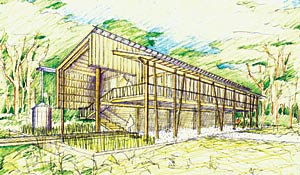Joe and Lucianne Carmichael were thinking green even before Hurricane Katrina. As the owners of A Studio in the Woods (ASITW), an artists center southeast of New Orleans, they have lived in the bottomland hardwood forests for 30 years using minimal energy resources. They rarely use air conditioning, even during humid Gulf Coast summers, and they always line-dry their clothes. The Carmichaels’ goal is to provide a retreat where artists can hone their craft—and give a lesson in living with nature. “The highest guiding principal of A Studio in the Woods is the opportunity to learn,” Lucianne says.

A Studio in the Woods, outside New Orleans, designed by architecture students from Tulane University and architect John Anderson.
Thinking that architecture students might also learn from ASTIW’s eco-friendly model, the Carmichaels donated their property to Tulane University in 2004 and sought student assistance in designing a new, green cottage for themselves (their old house will be converted into a public center). The focus on sustainability became that much more important after the hurricane. An architecture studio led by Eean McNaughton designed a new 1,322-square-foot house, including 735 square feet of porch-like exterior rooms, that will derive all of its energy needs from solar and geothermal sources.
While impressive prototypes for nouveau shotgun houses have been trotted out across the Gulf Coast during the past two years, the Carmichaels’ small cottage is the first in the region to participate in the U.S. Green Building Council’s new LEED-for-Homes program. It is aiming for Platinum certification. “In fact, we hope to sell energy back to the grid through a net-metering program,” says John Anderson, an ASITW board member and Mississippi-based architect. This past August, he began preparing construction documents and resolving some lingering design problems on a pro-bono basis.
Although the Tulane design studio is finished, ASITW’s learning opportunities will continue for a smaller number of architecture students who will perform research and documentation for the organization. These students will also learn from the fundraising process: Tulane has offered $80,000 toward the total construction cost of $300,000 but ASITW must still court other donors.
Anderson hopes the project’s smart design will attract funders who want to be aligned with model construction methods. “Part of the idea of doing this is promoting the concepts and tactics for the entire region,” he explains. “It’s meant to be a demonstration of what you can do, not just from the building perspective, but a lifestyle one.”




Post a comment to this article
Report Abusive Comment